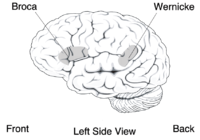
Photo from wikipedia
Repetitive motor behaviors are common in neurodevelopmental, psychiatric and neurological disorders. Despite their prevalence in certain clinical populations, our understanding of the neurobiological cause of repetitive behavior is lacking. Likewise,… Click to show full abstract
Repetitive motor behaviors are common in neurodevelopmental, psychiatric and neurological disorders. Despite their prevalence in certain clinical populations, our understanding of the neurobiological cause of repetitive behavior is lacking. Likewise, not knowing the pathophysiology has precluded efforts to find effective drug treatments. Our comparisons between mouse strains that differ in their expression of repetitive behavior showed an important role of the subthalamic nucleus (STN). In mice with high rates of repetitive behavior, we found significant differences in dendritic spine density, gene expression and neuronal activation in the STN. Taken together, these data show a hypoglutamatergic state. Furthermore, by using environmental enrichment to reduce repetitive behavior, we found evidence of increased glutamatergic tone in the STN with our measures of spine density and gene expression. These results suggest the STN is a major contributor to repetitive behavior expression and highlight the potential of drugs that increase STN function to reduce repetitive behavior in clinical populations.
Journal Title: Genes
Year Published: 2018
Link to full text (if available)
Share on Social Media: Sign Up to like & get
recommendations!